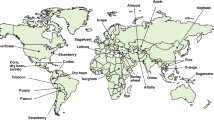Abstract
The use of crop genetic resources in improvement programmes should be the ultimate objective of all undertakings in the field of germplasm resources. The present situation and future direction of the use of crop germplasm in China was assessed from responses to a questionnaire distributed to 165 plant breeders and curators nationwide. The general opinions for the limiting factors of germplasm utilization were also evaluated. Responses from the questionnaire indicated that the use of germplasm in breeding programmes is much more important than the direct use of germplasm in crop production as cultivars released. Among different types of crop genetic resources, released varieties and breeding lines contribute more to crop breeding. Wild relatives and genetic stocks, however, are expected to play a greater role in the future. Landraces will remain important in improvement. Limited useful germplasm available to breeders is the basic reason for the insufficient use of germplasm in crop breeding at present. The complex reasons which affect the availability of useful germplasm involve the research level, links between breeder and curator and others. To counter these, we propose some suggestions and measures which can be implemented in the near future.
Similar content being viewed by others
References
Berdie, D.R., J.F. Anderson & M.A. Niebuhr, 1986. Questionnaires: Design and Use. 2nd Ed. The Scarecrow Press, Metuchen, N.J., London.
Fang, J.H., 1992. Major advances of research on crop genetic resources in China during 1986 to 1990. Crop Genet. Resources 3: 5–6.
Fang, J.H. & W.D. Gao, 1996. Great advances of key research on crop genetic resources in China during 1991 to 1995. Crop Genet. Resources 3: 1–2.
Frankel, O.H., 1970. Evaluation and utilization – introductory remarks. In: Frankel, O.H. & E. Bennett (Eds.), Genetic resources in plants – their exploration and conservation. Blackwell, Oxford & Edinburgh, 395–402.
Frankel, O.H., 1984. Genetic perspectives of germplasm conservation. In: Arber, W.K., K. Llimensee, W.J. Peacock & P. Starlinger (Eds.), Genetic manipulation: impact on man and society. Cambridge University Press, Cambridge.
Gill, K.S., 1989. Germplasmcollections and the public plant breeder. In: Brown, A.H.D., D.R. Marshall, O.H. Frankel & J.T. Williams (Eds.), The use of plant genetic resources. Cambridge University Press, Cambridge, 3–16.
Hawkes, J.G., 1977. The importance of wild germplasm in plant germplasm. Euphytica 26: 615–621.
Lou, X.Z., X.M. Liu & S.M. Wang, 1996. Present situation of plant genetic resources in the world. Crop Genet. Resources 4: 1–6.
Marshall, D.R., 1989. Limitations to the use of germplasm collections. In: Brown, A.H.D., D.R. Marshall, O.H. Frankel & J.T. Williams (Eds.), The use of plant genetic resources. Cambridge University Press, Cambridge, 105–120.
Morales, E.A.V., A.C.C. Valois & I.R.S. Costa, 1995. Core collections for gene banks with limited resources. In: Hodgkin, T., A.H.D. Brown, Th.J.L. van Hintum & E.A.V. Morales (Eds.), Core collections of plant Genetic Resources. John Wiley & Sons, Chichester, 241–249.
Author information
Authors and Affiliations
Rights and permissions
About this article
Cite this article
Li, Y., Wang, J., Cao, Y. et al. The use of genetic resources in crop improvement: Lessons from China. Genetic Resources and Crop Evolution 45, 181–186 (1998). https://doi.org/10.1023/A:1008691532378
Issue Date:
DOI: https://doi.org/10.1023/A:1008691532378




